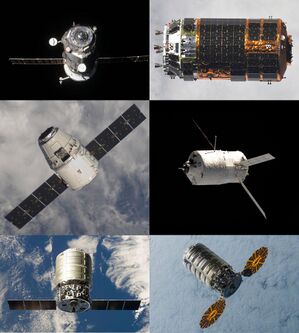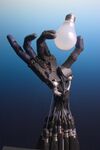Engineering:Cargo spacecraft
From HandWiki
Short description: Robotic spacecraft that is designed to resupply a space station

Cargo spacecraft are robotic spacecraft that are designed to carry cargo, possibly to support space stations' operation by transporting food, propellant and other supplies. This is different from a space probe, whose missions are to conduct scientific investigations.
Automated cargo spacecraft have been used since 1978 and have serviced Salyut 6, Salyut 7, Mir, the International Space Station and Tiangong space station.
Spacecraft
Current spacecraft
- the Russian Progress spacecraft[1]—developed by Russian Federal Space Agency
- the American Dragon 2 spacecraft[2]—developed under contract from NASA by SpaceX, a private spaceflight company, the only reusable cargo spacecraft
- the American Cygnus spacecraft[3]—developed under contract from NASA by Northrop Grumman Innovation Systems, a private spaceflight company
- the Chinese Tianzhou spacecraft[4]—developed by China Aerospace Science and Technology Corporation
Defunct or retired projects
- the Soviet optionally-crewed TKS spacecraft
- the European Automated Transfer Vehicle[5][6]—developed by the European Space Agency. The last vehicle, Georges Lemaître ATV, completed its mission in February, 2015.
- the Japanese H-II Transfer Vehicle[7]—developed by the Japan Aerospace Exploration Agency
- the American SpaceX Dragon—developed under contract from NASA by SpaceX, a private spaceflight company was retired after CRS-20 that launched March 2020.
Spacecraft in development
- The SpaceX Starship is planned to be a spacecraft launched as the second stage of a reusable launch vehicle. The concept is under development by SpaceX, as a private spaceflight project.[8] It is being designed to be a long-duration cargo- and passenger-carrying spacecraft.[9] While it will be tested on its own initially, it will be used on orbital launches with an additional booster stage, the Super Heavy, where Starship would serve as the second stage on a two-stage-to-orbit launch vehicle.[10] The combination of spacecraft and booster is called Starship as well.[11]
- In January 2016, NASA announced that Sierra Nevada Corporation's Dream Chaser had been awarded one of the contracts under the second round of the agency's Commercial Resupply Services contracts. NASA committed to purchasing a minimum of six resupply missions to the ISS.[12][needs update]
- The Earth Return Orbiter has been called the first "interplanetary cargo ship" due to its capacity as sample return mission from Mars.[13]
- Argo reusable cargo spacecraft is the first spacecraft being developed in Russia by a private company, with first flight expected in 2024.

Canceled projects
- The American private-sector Kistler K-1 from Rocketplane Kistler saw its contract with NASA terminated in October 2007 when the company failed to meet objectives. The contract was re-awarded to Orbital Sciences Corporation.[14][15]
Example Cargo
- Experimentation Equipment
- Phase Change Heat Exchanger
- Heat exchangers are devices used to maintain critical temperatures inside spacecraft. Heat exchangers may remedy the problem of not being able to regulate temperature in space because it has no atmosphere. The phase change heat exchanger has two modes of operation.[16] In the first mode, which uses a freeze cycle, heat exchange fluid is given to the upper flow passageway, which freezes the phase change material at the top.[17] The liquid phase change material at the top is then displaced by the newly-formed phase change material falling to the bottom. In the second mode, which uses a melt cycle, heat exchange fluid is given to the lower passageway to melt the phase change material at the bottom, causing the newly-formed liquid phase change material to be displaced towards the top.[17]

Graph generalizing process in a heat exchanger
- Heat exchangers are devices used to maintain critical temperatures inside spacecraft. Heat exchangers may remedy the problem of not being able to regulate temperature in space because it has no atmosphere. The phase change heat exchanger has two modes of operation.[16] In the first mode, which uses a freeze cycle, heat exchange fluid is given to the upper flow passageway, which freezes the phase change material at the top.[17] The liquid phase change material at the top is then displaced by the newly-formed phase change material falling to the bottom. In the second mode, which uses a melt cycle, heat exchange fluid is given to the lower passageway to melt the phase change material at the bottom, causing the newly-formed liquid phase change material to be displaced towards the top.[17]
- Nanotube Solar Cell
- A nanotube solar cell is a solar cell designed by the aerospace company Nanoracks that absorbs sunlight more efficiently than traditional solar cells. The Nanotube Solar Cell is three-dimensional, which allows it to have access to the Sun's light in space at every angle while being stationary itself.[18] It is composed of 3-D, carbon nanotube-based photovoltaic devices and copper-zinc-tin-sulfide photo absorbers. They can be implemented into a space station's solar panels to allow for higher power production and usage efficiency.[18] The efficiency of Nanotube Solar Cells also allow for the station to have higher reserves of power to run numerous experiments.[19]
- Biomolecule Sequencer
- A biomolecule sequencer is a tool that can be used by crew members to sequence the DNA of microorganisms outside of Earth.[18] Before the production of the biomolecule sequencer, DNA sequencing was limited to Earth because of the equipment and materials required. The new technology eliminates this restriction, with the added benefit of being able to be used in space. The device can also be used to test the DNA of crew members to monitor their health and bodily reactions to space station projects.[20] In the event that a research study needs to be performed on a space station, the biomolecule sequencer can be used to gather needed biological data.[21]

NASA astronaut Kathleen Rubins used a biomolecule sequencer in the first-ever sequencing of DNA in space
- A biomolecule sequencer is a tool that can be used by crew members to sequence the DNA of microorganisms outside of Earth.[18] Before the production of the biomolecule sequencer, DNA sequencing was limited to Earth because of the equipment and materials required. The new technology eliminates this restriction, with the added benefit of being able to be used in space. The device can also be used to test the DNA of crew members to monitor their health and bodily reactions to space station projects.[20] In the event that a research study needs to be performed on a space station, the biomolecule sequencer can be used to gather needed biological data.[21]
- Phase Change Heat Exchanger
- Essential Equipment
- Compressed Air
- Compressed air is used by astronauts to manage their air supply.[22] It is also utilized for research experiments, and to power boosters for both the ISS and other space vehicles.[22] Compressed air equipment sent to the ISS must be very efficient and low power due to the nature of space to break up fluids.
- Compressed Air
See also
- Comparison of space station cargo vehicles
- Space transport
- Uncrewed spaceflights to the International Space Station
- Sample return mission
References
- ↑ Gunter's Space Page: Progress-M 1M - 10M (11F615A60, 7KTGM).
- ↑ "F9/Dragon Will Replace the Cargo Transport Function of the Space Shuttle after 2010". SpaceX. 2008-12-23. http://www.spacex.com/press.php?page=20081223.
- ↑ "Canadarm2 Captures Cygnus". http://www.nasa.gov/content/canadarm2-captures-cygnus/index.html#.UklgvD-S8XM.
- ↑ "China launches its first unmanned cargo spacecraft". phys.org. 2017-04-20. https://phys.org/news/2017-04-china-unmanned-cargo-spacecraft.html.
- ↑ ESA Automatic Transfer Vehicle, http://www.esa.int/SPECIALS/ATV/index.html
- ↑ Thales Alenia Space ATV & ISS Modules, http://www.thalesaleniaspace-issmodules.com/atv
- ↑ "NASA Sets Briefing, TV Coverage of Japan's First Cargo Spacecraft". NASA. http://www.nasa.gov/home/hqnews/2009/aug/HQ_M09-164_HTV_Briefing.html.
- ↑ Berger, Eric (29 September 2019). "Elon Musk, Man of Steel, reveals his stainless Starship". Ars Technica. https://arstechnica.com/features/2019/09/after-starship-unveiling-mars-seems-a-little-closer/.
- ↑ Lawler, Richard (20 November 2018). "SpaceX BFR has a new name: Starship". Engadget. https://www.engadget.com/2018/11/20/starship-bfr-spacex/.
- ↑ Boyle, Alan (19 November 2018). "Goodbye, BFR … hello, Starship: Elon Musk gives a classic name to his Mars spaceship". GeekWire. https://www.geekwire.com/2018/goodbye-bfr-hello-starship-elon-musk-gives-classic-name-mars-spaceship/. "Starship is the spaceship/upper stage & Super Heavy is the rocket booster needed to escape Earth’s deep gravity well (not needed for other planets or moons)"
- ↑ "Starship". SpaceX. https://www.spacex.com/starship.
- ↑ "NASA Awards International Space Station Cargo Transport Contracts". January 14, 2016. https://www.nasa.gov/press-release/nasa-awards-international-space-station-cargo-transport-contracts.
- ↑ Jonathan Amos (29 July 2020). "Airbus to build 'first interplanetary cargo ship'". https://www.bbc.com/news/science-environment-53575353.
- ↑ Space.com - Rocketplane Kistler Appeals NASA Decision to Terminate COTS Agreement (22 October 2007)
- ↑ Orbital Wins $171 Million Space Station Re-Supply Demo Deal (19 February 2008)
- ↑ Longardner, Robert L. & William J. Longardner, "Phase change heat exchanger", US patent 5220954, published 1993-06-22, assigned to Shape Inc.
- ↑ 17.0 17.1 Rostami, Morteza; Zahmatkesh, A. (December 2013). "Heat Transfer Modeling of Phase Change Materials in Multiple Plates Heat Exchanger". Research Journal of Applied Sciences, Engineering and Technology (Maxwell Scientific Organization): 4. https://www.researchgate.net/publication/260676732.
- ↑ 18.0 18.1 18.2 Rainey, Kristine (2016-06-16). "Cargo Spacecraft to Carry Wide Range of Research". http://www.nasa.gov/mission_pages/station/research/news/crs9_cargo.
- ↑ "Solar Cell Research || The Prashant Kamat lab at the University of Notre Dame". https://www3.nd.edu/~kamatlab/research_solarCells.html.
- ↑ Burton, Aaron; John, Kristen; Botkin, Douglas; Castro, Sarah (March 2016). "The Biomolecule Sequencer Project: Nanopore sequencing as a dual-use technology for crew health and astrobiology investigations". 47th Lunar and Planetary Science Conference: 2. https://www.researchgate.net/publication/297234720.
- ↑ John, K. K.; Botkin, D. J.; Burton, A. S.; Castro-Wallace, S. L.; Chaput, J. D.; Dworkin, J. P.; Lupisella, M. L.; Mason, C. E. et al. (2016-10-01). "Biomolecule Sequencer: Nanopore Sequencing Technology for In-Situ Environmental Monitoring and Astrobiology". 3Rd International Workshop on Instrumentation for Planetary Mission 1980: 4103. Bibcode: 2016LPICo1980.4103J. http://adsabs.harvard.edu/abs/2016LPICo1980.4103J.
- ↑ 22.0 22.1 "The Humble Air Compressor – The Unsung Hero Of Space!" (in en-US). 2019-03-03. http://cosmonautexperience.com/the-humble-air-compressor-the-unsung-hero-of-space/.



